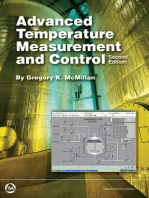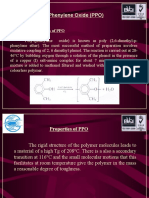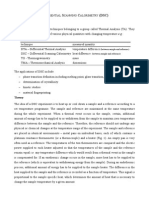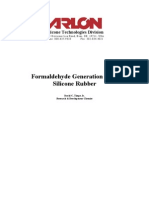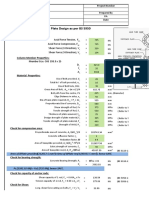Thermomechanical Analysis (TMA) (NETZSCH)
Thermomechanical Analysis (TMA) (NETZSCH)
Uploaded by
BülentAlkanCopyright:
Available Formats
Thermomechanical Analysis (TMA) (NETZSCH)
Thermomechanical Analysis (TMA) (NETZSCH)
Uploaded by
BülentAlkanOriginal Title
Copyright
Available Formats
Share this document
Did you find this document useful?
Is this content inappropriate?
Copyright:
Available Formats
Thermomechanical Analysis (TMA) (NETZSCH)
Thermomechanical Analysis (TMA) (NETZSCH)
Uploaded by
BülentAlkanCopyright:
Available Formats
Leading Thermal Analysis
Thermomechanical Analysis TMA
Method, Technique, Applications
Analyzing & Testing
TMA 402 F1/F3
22
Thermomechanical Analysis TMA
Thermomechanical analysis (TMA)
determines dimensional changes of
solids, liquids or pasty materials as a
function of temperature and/or time
under a dened mechanical force (DIN
51 005, ASTM E 831, ASTM D 696,
ASTM D 3386, ISO 11359 Parts 1 to
3). It is closely related to dilatometry,
which determines the length change of
samples under negligible load (DIN
51 045).
Many materials undergo changes of
their thermomechanical properties
during heating or cooling. For example,
phase changes, sintering steps or
softening can occur in addition to
thermal expansion. TMA analyses can
hereby provide valuable insight into the
composition, structure, production
conditions or application possibilities for
various materials.
The application range of instruments
for thermomechanical analysis extends
from quality control to research and
development. Typical domains include
plastics and elastomers, paints and dyes,
composite materials, adhesives, lms
and bers, ceramics, glass and metals.
Operating Principle
Irrespective of the selected type of
deformation (expansion, compression,
penetration, tension or bending),
every length change in the sample is
communicated to a highly sensitive
inductive displacement transducer
(LVDT) via a push rod and transformed
into a digital signal. The push rod and
corresponding sample holders of fused
silica or aluminum oxide can be quickly
and easily interchanged to optimize the
system to the respective application.
furnace
sample
push rod
sample carrier
height setting
displacement
transducer
actuator
(static or modulating)
force sensor
TMA: Operating principle
3
Results and Accuracy
The linear thermal expansion is an
important variable for assessing the
behavior of a material.
This chart shows the thermal expansion
(dL/L
0
in %) and the resulting curve of
the coefcient of thermal expansion
(CTE in 1/K) of sapphire compared to
literature values (circles). The results
demonstrate the high accuracy which
can be achieved using the TMA 402
Hyperion
.
TMA 402 F1 Hyperion
with
double furnace hoist
At a Glance
What sets the new
TMA 402 F1/F3 Hyperion
apart:
A modular concept of
interchangeable furnaces
covering the temperature range
from -150C to 1550C, which
are also compatible with other
NETZSCH instruments
The large number of sample
holder types and adjustment
possibilities
The broad range of force,
without added weight, digitally
programmable from -3 N to 3 N
44
TMA 402 Hyperion
Trend-Setting Technology
The Heart of the TMA 402 Hyperion
is a Highly Precise Inductive
Displacement Transducer (LVDT)
This technology has stood the test of
time; it is also used for dilatometers and
allows measurement of even the smallest
of length changes, into the nanometer
range (digital resolution of 0.125 nm).
Vacuum-tight Thermostatic
Measuring System
The entire TMA 402 Hyperion
measuring system is thermally stabilized
via water-cooling. This ensures that the
measurement will not be inuenced by
heat from the furnace or by temperature
uctuations in the local environment.
All joints have a vacuum-tight design
to allow measurements in a highly pure
atmosphere or under vacuum. Pressures
of less than 10
-4
mbar can be achieved
with the use of a turbomolecular pump.
In combination with the integrated mass
ow controllers (MFC) for purge
and protective gases (optional in the
TMA 402 F3), measurements in highly
pure inert gas or in oxidizing
atmospheres can be optimally
controlled.
Further Information
www.netzsch.com/n10830
5
Simultaneous Measurement of Force
and Displacement Signal
The force operating on the sample is
generated electromagnetically in the
TMA 402 Hyperion
. This guarantees
a quick response time for experiments
with a changing load, e.g. tests on
creep behavior. A highly sensitive force
sensor (digital resolution < 0.01 mN)
continuously measures the force
exerted via the push rod and readjusts
it automatically. This sets the TMA 402
Hyperion
apart from other instruments,
which use only preset values.
Precise Force Control
The electronic control system for the
TMA 402 Hyperion
allows forces to
be set in the mN-range. This enables
testing even on sensitive materials such
as thin bers or lms. The force
operating on the sample can be altered
via the software in a stepwise or linear
fashion. This makes it particularly simple
to carry out such analyses as creep or
stress sweep tests. The premium version
of the Hyperion
, the TMA 402 F1,
provides even more capabilities. From
single pulse in rectangular or ramp
form to continuous modulation with a
customizable frequency (up to 1 Hz),
every possibility is covered. This model is
particularly well-suited for determining
visco-elastic material properties such as
elasticity and creep modulus.
Technical Data TMA 402 F1/F3
Max. sample length 30 mm
Measuring Range 5000 m (total) / 500 m
Dig. resolution (length) 1.25 nm / 0.125 nm
Force range
Dig. resolution (force) < 0.01 mN
Modulated force Up to 1 Hz (only F1)
Final vacuum pressure < 10
-4
mbar
Gas connections
MFC Standard (F3 optional)
furnace
sample carrier
system
thermostatic
controlled support
force sensor displacement transducer
loading cell
vacuum-tight
housing
TMA 402 Hyperion
:
Sectional Drawing
5
0.001 N to 3 N in steps of 0.2 mN (tension or pressure)
Protective gas, 2 purge gases
66
Common System Congurations by Temperature Range
-150C to 1000C
Steel furnace with LN
2
cooling, sample holder system
of fused silica, Type K thermocouple
RT to 1550C
SiC furnace, sample holder system of Al
2
O
3
,
Type S thermocouple
Other congurations can easily be realized due to the modular concept.
Highest Precision Maximum Flexibility
Interchangeable Furnaces
The furnaces can be easily interchanged
among various high-temperature series
thermal analysis instruments (STA 449
Jupiter
, DSC 404 Pegasus
). The
selection of available furnace models is
continuously being expanded. The TMA
402 Hyperion
can thus cover the entire
temperature range from -150C to
1550C and is prepared for temperature
extensions.
Sample Holder Systems Tailored to
the Task
Depending upon the question at hand
and the geometry of the sample, the
operator has a variety of sample holders
to choose from. Holding devices for
expansion, penetration, and tension
measurements are available, as well as
push rods and supports for analyses
in 3-point bending. Accessories for
the temperature range up to 1000C
are made of fused silica. For the high-
temperature range, aluminum oxide
varieties are available.
In the TMA 402 Hyperion
, the
thermocouple can be changed quickly
and easily. Besides type K, the S and E
varieties are also available. The system
electronics recognizes the installed
sensor automatically.
Special Sample Holders
With the help of special sample
containers, the expansion behavior of
powders, pastes and liquids can be
analyzed, as can metals all the way
to the melting point. Accessories for
experiments on swelling behavior upon
immersion are also available.
Coupling with MS / FT-IR
To analyze gases evolving upon heating
(EGA), the TMA 402 Hyperion
can be
coupled to a mass spectrometer and/or
FT-IR spectrometer.
The Modular Design of the TMA 402
Hyperion
Makes it Unique among
the Competition
To adjust the instrument for the
respective temperature ranges, all
that needs to be done is to exchange
the furnace. This can be done by the
operator. Due to the double furnace
hoist, switching to a second furnace
takes only moments.
Further Information
www.netzsch.com/n10830
77
Feature Advantage Benet
Modular concept
Furnaces are interchangeable and compat-
ible with other NETZSCH instruments
Synergies in procuring and operating, easy and
cost-effective expansion and retrotting
Gas ows controllable via
software
Programmable atmosphere change
Analysis of, for example, oxidation behavior
without manual valve operation
Digitally programmable
force control up to 3 N
Force alteration (linear/stepwise),
continuous force modulation (TMA 402 F1)
Determination of visco-elastic properties
A variety of accessories,
e.g. special sample hold-
ers, immersion baths
Extension of the application range
Measurement of powders, liquids, pastes or
metals (until melting), immersion measurements
Sample holder and push rods
(fused silica, aluminum oxide)
8 8
Proteus
Software for the TMA 402 F1/F3 Hyperion
The software includes everything
necessary for carrying out
measurements and evaluating the
results. Simple menu navigation and
automated routines make the
software easy to operate while allowing
for complex analyses.
General Software Characteristics:
For Windows
XP and Windows
7
operating systems
Multi-tasking: Simultaneous
measurement and evaluation
Multi-moduling: Operation of several
pieces of equipment via a single PC
Combined analysis: Comparison and/
or evaluation of TMA, DMA, DEA,
DIL, DSC, TGA and STA
measurements in a single
presentation
Labeling: Text elements can be
entered and positioned freely
Calculation of the 1
st
and 2
nd
derivative
Export of graphics and data
Selectable colors and line types
Saving and recovery of the analysis
status
Macro-recorder (optional)
Context-based help system
Temperature calibration
Software developed by ISO-certied
enterprise of the NETZSCH Group
99
Features Specic to TMA:
Various correction possibilities for
taking the expansion behavior of the
system itself into account, as well as
offset and sample length correction
Automatic adjustment of sign for
force and displacement signal to the
measurement conguration being
used
Routines for the determination of
characteristic temperatures such as
onset, peak and nal temperatures
Evaluation of glass transitions and
softening points in accordance with
DIN
Automatic shut-off at softening point
Expansion coefcients: Calculation
and presentation of the technical and
physical expansion coefcients
Automatic sintering step evaluation
Measurements with variable force:
Determination of visco-elastic
properties
Extensions
c-DTA
function: Evaluation of the
temperature signal for endothermic
or exothermic effects
Thermokinetics:
Extensive characterization and
optimization of sintering processes
Density Software: Determination of
changes in volume and density until
the liquid state
Peak Separation:
The separation of overlapping effects
Rate-Controlled Sintering (RCS)
Software: Sintering with a constant
shrinkage rate (optional)
10 10
Meaningful Material Characterization
in the Low-Temperature Fields
Tension Test on a Polymer Film
Orientation effects, stretch conditions
and shrinkage are measured under load
for lms.
In this example, the expansion and
contraction behavior of a 40-m thick
polycarbonate lm was tested under
tensile load. The results varied
considerably depending on the load.
Under low amounts of force (5 mN), the
lm contracted at higher temperatures;
however, it expanded if greater force
(50 mN) was applied.
Application Examples
11 11
Meaningful Material Characterization
in the Low-Temperature Fields
Visco-Elastic Properties of
Polytetrauoroethylene
The combination of a 3-point bending
sample holder and a modulated sample
force allows the visco-elastic properties
of a material to be determined.
A PTFE bar was measured between
-150C and 150C under (rectangular)
modulated force (xed static force
of 0.2 N and three different dynamic
forces). Based on the expansion data
and the sample geometry, the storage
modulus E can be calculated as a
function of temperature.
The three typical PTFE transformations
are clearly visible at around -100C
( transition), between 0C and 50C
(crystal to condis-crystal transformation)
and above 100C (glass transition).
Behavior of Polymers under Pressure
The extent to which the elastic
properties of a seal remain intact after
being subjected to a constant load of
longer duration is very important.
To test this, an elastomer seal was
loaded with a force of 3 N and then
relieved to 5 mN. Following a 40-hour
load time, 21% compression was
observed. After a 30-minute relief
period, the compression had reversed
by 16.2%; after 60 min, by 16.8%. The
visco-elastic properties of the elastomer
were such that the sample did not
return to its original length even after
30 hours.
12 12
Meaningful Material Characterization
in the High-Temperature Fields
Refractory Materials
The life span and efciency of any
technical furnace can be greatly
improved with an appropriate
conguration, along with a high-quality
interior lining made of refractory
materials. An important criterion in
assessing such materials is thermal
expansion.
Shown in the example is the thermal
behavior of a typical coarse-grained
refractory material. At the beginning of
the measurement, the -
transformation of the tridymite is rst
observed, followed by the -
transformation of the free quartz
between 548C and 580C. After
another transformation between
1233C and 1299C, the material
begins to soften at 1450C.
Sintering of Aluminum Titanate
One use of aluminum titanate is as a
carrier material for catalytic converters in
the automobile industry.
Shown here is the measurement of an
aluminum titanate green body in the
temperature range from RT to 1450C
with a subsequent isothermal line at
1450C of 7 hours. During heating, a
shrinkage of 12.7% is observed.
Sintering takes place in two steps with a
maximum sintering rate of 0.31%/min.
In the subsequent isothermal phase,
further shrinkage of 0.6% occurs.
To optimize the sintering process, an
RCS measurement (rate-controlled
sintering; optionally available) can
additionally be carried out.
Application Examples
13 13
Measurement with EGA
(Evolved Gas Analysis)
A clay sample (powder) was tested in
air using a TMA-MS (Aolos
) coupling
in the temperature range from RT to
800C.
At the beginning of the measurement,
the adsorptively bound water and the
interlayer water are released (shrinkage
of 0.01%). Above 300C, the samples
organic constituents burn up (release of
water, m18, and CO
2
, m44). There is no
visible inuence on the expansion curve
here, due to the very low proportion.
Between 487C and 536C, dehydro-
xylation of the samples clay mineral
content takes place.
Associated with that is a sample
shrinkage of 0.05%.
14 14
Expertise in Service
Our Expertise Service
All over the world, the name NETZSCH
stands for comprehensive support and
expert, reliable service, before and
after sale. Our qualied personnel
from the technical service and
application departments are always
available for consultation.
In special training programs tailored
for you and your employees, you will
learn to tap the full potential of your
instrument.
To maintain and protect your
investment, you will be accompanied
by our experienced service team over
the entire life span of your instrument.
Summary of Our Services
Installation and commissioning
Hotline service
Preventive maintenance
Calibration service
IQ / OQ / PQ
On-site repairs with emergency
service for NETZSCH components
Moving / exchange service
Technical information service
Spare parts assistance
15
Our Expertise Applications Laboratories
The NETZSCH Thermal Analysis
applications laboratories are a
procient partner for nearly any
Thermal Analysis issue. Our
involvement in your projects begins
with proper sample preparation and
continues through meticulous
examination and interpretation of the
measurement results. Our diverse
methods and over 30 diferent
state-of-the-art measuring stations
will provide ready-made solutions for
all your thermal needs.
Within the realm of thermal analysis
and the measurement of thermo-
physical properties, we ofer you a
comprehensive line of the most
diverse analysis techniques for
materials characterization (solids,
powders and liquids).
Measurements can be carried out on
samples of the most varied of geome-
tries and congurations. You will
receive high-precision measurement
results and valuable interpretations
from us in the shortest possible time.
This will enable you to precisely
characterize new materials and
components before actual
deployment, minimize risks of failure,
and gain decisive advantages over
your competitors.
For production problems, we can work
with you to analyze concerns and
develop solutions. The minimal
investment in our testing and services
will reward you with reduced down
time and reject rates, helping you
optimize your processes across the
board.
www.netzsch.com N
G
B
T
M
A
4
0
2
F
1
/
F
3
E
N
1
0
0
0
0
9
1
3
L
H
T
e
c
h
n
i
c
a
l
s
p
e
c
i
f
i
c
a
t
i
o
n
s
a
r
e
s
u
b
j
e
c
t
t
o
c
h
a
n
g
e
.
NETZSCH-Gertebau GmbH
Wittelsbacherstrae 42
95100 Selb
Germany
Tel.: +49 9287 881-0
Fax: +49 9287 881 505
at@netzsch.com
When it comes to Thermal Analysis, Adiabatic Reaction Calorimetry and
the determination of Thermophysical Properties, NETZSCH has it covered.
Our 50 years of applications experience, broad state-of-the-art product line
and comprehensive service oferings ensure that our solutions will not only
meet your every requirement but also exceed your every expectation.
The NETZSCH Group is a mid-sized, family-owned German company engaging in
the manufacture of machinery and instrumentation with worldwide production,
sales, and service branches.
The three Business Units Analyzing & Testing, Grinding & Dispersing and
Pumps & Systems provide tailored solutions for highest-level needs. Over
3,000 employees at 163 sales and production centers in 28 countries across
the globe guarantee that expert service is never far from our customers.
www.netzsch.com/n10830
You might also like
- Overcladding External Walls of LPS BuildingsDocument124 pagesOvercladding External Walls of LPS BuildingsOliver SmithNo ratings yet
- Hexamoll DINCH TDS 202305Document3 pagesHexamoll DINCH TDS 202305吉启周No ratings yet
- Advanced Temperature Measurement and Control, Second EditionFrom EverandAdvanced Temperature Measurement and Control, Second EditionNo ratings yet
- AAPG M67 Seals, Traps, & The Petroleum System PDFDocument310 pagesAAPG M67 Seals, Traps, & The Petroleum System PDFCarolina Castaño Uribe100% (1)
- Exp - S5 - Vapour Liquid EquilibriumDocument6 pagesExp - S5 - Vapour Liquid EquilibriumAnuj SrivastavaNo ratings yet
- Exxonmobil New Exxpro 3563 Specialty Elastomer With Superior Impermeability For TiresDocument20 pagesExxonmobil New Exxpro 3563 Specialty Elastomer With Superior Impermeability For TiresAmir Hossein ShahdadiNo ratings yet
- Heat Treatment On Magnesium Aluminum Zinc Alloy AZ91DDocument29 pagesHeat Treatment On Magnesium Aluminum Zinc Alloy AZ91Dgustavojorge12No ratings yet
- World's Fastest Uxer Is HereDocument4 pagesWorld's Fastest Uxer Is HereTrishia PentecostesNo ratings yet
- Industrial Applications of Infrared Thermography: How Infrared Analysis Can be Used to Improve Equipment InspectionFrom EverandIndustrial Applications of Infrared Thermography: How Infrared Analysis Can be Used to Improve Equipment InspectionRating: 4.5 out of 5 stars4.5/5 (3)
- Thermal Methods of AnalysisDocument31 pagesThermal Methods of AnalysisTshegofatso GraceNo ratings yet
- Plastic StandardsDocument10 pagesPlastic StandardsMarian BelmisNo ratings yet
- Pharmaceutics 1st STERILIZATION Unit 4Document32 pagesPharmaceutics 1st STERILIZATION Unit 4SHAIK NISHARNo ratings yet
- Thermal Analisys PharmaceuticalsDocument43 pagesThermal Analisys PharmaceuticalsGus Ortega PedrazaNo ratings yet
- Temperature Programmed Desorption TPDDocument18 pagesTemperature Programmed Desorption TPDyiyiNo ratings yet
- Lectrure Thermal AnalysisDocument36 pagesLectrure Thermal Analysisaanfebrianto1993No ratings yet
- 儀分 Ch31 ThermalDocument57 pages儀分 Ch31 ThermalSaurabh ShashankNo ratings yet
- A Systematic Approach For Conceptual and Sustainable Process Design: Production of Methylamines From Methanol and AmmoniaDocument141 pagesA Systematic Approach For Conceptual and Sustainable Process Design: Production of Methylamines From Methanol and Ammonialucia corradini deaneNo ratings yet
- Thermal Analysis 3Document61 pagesThermal Analysis 3Itz HamzaNo ratings yet
- Application of PhotocatalystDocument5 pagesApplication of PhotocatalystShakaibQureshiNo ratings yet
- Diethylenetriamine DetaDocument2 pagesDiethylenetriamine DetajangreeNo ratings yet
- Novel Report TGA TDADocument10 pagesNovel Report TGA TDASheraz AliNo ratings yet
- Thermal Analysis: Presented By: MD Meraj Anjum M.Pharm 1 Year Bbau, LucknowDocument25 pagesThermal Analysis: Presented By: MD Meraj Anjum M.Pharm 1 Year Bbau, LucknowA. MerajNo ratings yet
- ASTM Plastic TestingDocument2 pagesASTM Plastic TestingAnish KumarNo ratings yet
- Disperse SystemsDocument4 pagesDisperse SystemsAbby CruzNo ratings yet
- DSC Beginners GuideDocument9 pagesDSC Beginners GuidelumineurNo ratings yet
- DSC 214 Polyma - Differential Scanning Calorimeter (-170°C To 600°C)Document24 pagesDSC 214 Polyma - Differential Scanning Calorimeter (-170°C To 600°C)NETZSCH - Leading Thermal AnalysisNo ratings yet
- PPO SlideDocument29 pagesPPO SlideRadhashyam GiriNo ratings yet
- PDS Chemfos Liquid AdditiveDocument3 pagesPDS Chemfos Liquid AdditiveKenieta100% (1)
- Tri-ACT® 1820: Safety Data SheetDocument13 pagesTri-ACT® 1820: Safety Data SheetEDUARDONo ratings yet
- Partition Coefficients and Their UsesDocument92 pagesPartition Coefficients and Their UsesquelenigNo ratings yet
- Thermal Characterization of Textile MaterialsDocument40 pagesThermal Characterization of Textile Materialssubhaxyz9365No ratings yet
- Conditions of Sample Preparation For Quantitative X-Ray Diffraction of Cement ClinkerDocument6 pagesConditions of Sample Preparation For Quantitative X-Ray Diffraction of Cement ClinkeryinglvNo ratings yet
- Thermal Analysis: Terry A. Ring Chemical Engineering University of UtahDocument18 pagesThermal Analysis: Terry A. Ring Chemical Engineering University of UtahAhmed Halawa100% (1)
- Thermal Methods of AnalysisDocument4 pagesThermal Methods of AnalysisRay MondyNo ratings yet
- LENTON Furnaces BrochureDocument20 pagesLENTON Furnaces Brochureantho_lombokNo ratings yet
- DSC - DTA - TG PrezDocument9 pagesDSC - DTA - TG PrezhydromaniaNo ratings yet
- Packaging ProductsDocument42 pagesPackaging ProductsSheena GagarinNo ratings yet
- DSC - Basics PrincipleDocument2 pagesDSC - Basics PrincipleSayantan ChakrabortyNo ratings yet
- Powder Technology (POWDER TECHNOL)Document8 pagesPowder Technology (POWDER TECHNOL)Dappa DavidNo ratings yet
- Thermal Analysis: G. GalbácsDocument9 pagesThermal Analysis: G. GalbácsSanchit KumarNo ratings yet
- Lecture 6 Dta & Dsc01Document22 pagesLecture 6 Dta & Dsc01ZUL KAMARUDDINNo ratings yet
- 11 Pure Steam System PDFDocument76 pages11 Pure Steam System PDFeaeapewNo ratings yet
- Chapter 8 - PolymerDocument24 pagesChapter 8 - PolymerAsh DenemNo ratings yet
- Effect of Phase Transformation On Optical Properties of Zntio3 Ceramic Powder Prepared by Sol-Gel MethodDocument18 pagesEffect of Phase Transformation On Optical Properties of Zntio3 Ceramic Powder Prepared by Sol-Gel MethodIJAR JOURNALNo ratings yet
- De Leenheer A.p., Lambert W. (Eds.) Modern Chromatographic Analysis of Vitamins, Revised and Expanded (3ed., CRC, 2000) (ISBN 0824703162) (606s)Document606 pagesDe Leenheer A.p., Lambert W. (Eds.) Modern Chromatographic Analysis of Vitamins, Revised and Expanded (3ed., CRC, 2000) (ISBN 0824703162) (606s)Edwin Franco100% (1)
- CephalosporinDocument8 pagesCephalosporinvidagurlNo ratings yet
- Bayer Process PDFDocument2 pagesBayer Process PDFFrandi CahyaNo ratings yet
- Collagen Hydrolyzated - Gelatine Based - Biocompatibility 28Document37 pagesCollagen Hydrolyzated - Gelatine Based - Biocompatibility 28Mirela MihalteanuNo ratings yet
- Bruker AXS XRF Sample Prep Fused Vs PressedDocument93 pagesBruker AXS XRF Sample Prep Fused Vs PressedbochofiloNo ratings yet
- Polymer BlendDocument5 pagesPolymer BlendghoshikhaNo ratings yet
- Eurostandard CatalogDocument80 pagesEurostandard CatalogMohammad Rashad BarakatNo ratings yet
- Sol-Gel: A Low Temperature Process For The Materials of The New MillenniumDocument4 pagesSol-Gel: A Low Temperature Process For The Materials of The New MillenniumCarlos ChavesNo ratings yet
- Icp MSDocument68 pagesIcp MSluongthuong100% (2)
- Thermogravimetric Analysis (TGA) : The Change in Weight Is Plotted Against TemperatureDocument19 pagesThermogravimetric Analysis (TGA) : The Change in Weight Is Plotted Against TemperatureSumedha ThakurNo ratings yet
- Advantages and Disadvantages of PolypropyleneDocument3 pagesAdvantages and Disadvantages of PolypropyleneMika PelagioNo ratings yet
- Formaldehyde Generation From Silicone RubberDocument5 pagesFormaldehyde Generation From Silicone RubberPrabagar Dhayal100% (1)
- Synthesis and Property Comparison of Silicone PolymersDocument3 pagesSynthesis and Property Comparison of Silicone PolymersDaniel RodmanNo ratings yet
- Practical Titration PDFDocument164 pagesPractical Titration PDFCojocaru George0% (1)
- TMA (Thermomechanical Analysis) and Its ApplicationDocument18 pagesTMA (Thermomechanical Analysis) and Its Applicationbt19108055 Amarjeet KumarNo ratings yet
- NETZSCH Analyzing and Testing Product OverviewDocument4 pagesNETZSCH Analyzing and Testing Product OverviewNETZSCH - Leading Thermal Analysis100% (1)
- ModuLab MTSDocument8 pagesModuLab MTSJod JDNo ratings yet
- TG 209 F1 Libra E 0812Document20 pagesTG 209 F1 Libra E 0812Gaurav AcharyaNo ratings yet
- Thermomechanical Analysis: For All RequirementsDocument14 pagesThermomechanical Analysis: For All RequirementsyahiaouiNo ratings yet
- Electron Microscopy in Material ScienceDocument66 pagesElectron Microscopy in Material ScienceBülentAlkanNo ratings yet
- Fine Ceramic TreeDocument1 pageFine Ceramic TreeBülentAlkanNo ratings yet
- Piezoelectric History: Discovery and InsightsDocument5 pagesPiezoelectric History: Discovery and InsightsBülentAlkanNo ratings yet
- Electron Microscopy in Material ScienceDocument66 pagesElectron Microscopy in Material ScienceBülentAlkanNo ratings yet
- Piezoelectric History: Discovery and InsightsDocument5 pagesPiezoelectric History: Discovery and InsightsBülentAlkanNo ratings yet
- Professor of Materials Science and Engineering Carnegie Mellon University Pittsburgh, PennsylvaniaDocument60 pagesProfessor of Materials Science and Engineering Carnegie Mellon University Pittsburgh, PennsylvaniaBülentAlkanNo ratings yet
- Reader at Work1Document377 pagesReader at Work1serkan100% (3)
- IELTS Express Intermediate CourseBookDocument136 pagesIELTS Express Intermediate CourseBookBülentAlkanNo ratings yet
- Development of Sansevieria Trifasciata - Carbon Fi PDFDocument11 pagesDevelopment of Sansevieria Trifasciata - Carbon Fi PDFColeene Mhae Villamar GalanoNo ratings yet
- 9 - AsphaltDocument38 pages9 - AsphaltSyed Muzamil AhmedNo ratings yet
- Aluminium Bronze To Bs 1400: Ab1Document1 pageAluminium Bronze To Bs 1400: Ab1Fred Duarte CaldeiraNo ratings yet
- RTV Is800 SeriesDocument4 pagesRTV Is800 SeriesFaraan KhanNo ratings yet
- Technical Seminar OrgDocument18 pagesTechnical Seminar OrgDarshan BhandariNo ratings yet
- Certain Types of Carbon Black Used in TiresDocument2 pagesCertain Types of Carbon Black Used in TiresPLASTIC LAB CBDNo ratings yet
- Electrocatalytic Reduction of CO2 and CO To Multi-Carbon Compounds Over Cu-Based CatalystsDocument18 pagesElectrocatalytic Reduction of CO2 and CO To Multi-Carbon Compounds Over Cu-Based CatalystsCB Dong SuwonNo ratings yet
- FEMA 355E - State of The Art Report On Past Performance of Steel Moment-Frame Buildings in Earthquakes - 2000 PDFDocument200 pagesFEMA 355E - State of The Art Report On Past Performance of Steel Moment-Frame Buildings in Earthquakes - 2000 PDFbrianchen06No ratings yet
- BulacanDocument441 pagesBulacanLuisa Alyanna OniaNo ratings yet
- Anchor Bolt As Per BS CodeDocument16 pagesAnchor Bolt As Per BS Codesuvodip khanNo ratings yet
- Caustic 4Document1 pageCaustic 4Masoud SalehiNo ratings yet
- Test Paper For Lab AttendantDocument4 pagesTest Paper For Lab AttendantHaider Zaidi100% (1)
- 11th Floor Accomplishment As of 8/9/21 Units 1st Coat 2nd Coat Flood Test Remarks Unit ADocument27 pages11th Floor Accomplishment As of 8/9/21 Units 1st Coat 2nd Coat Flood Test Remarks Unit Afrancis baldonadoNo ratings yet
- Structural Studies and Modelling of Oxygen Transport in Barrier Materials For Food PackagingDocument55 pagesStructural Studies and Modelling of Oxygen Transport in Barrier Materials For Food PackagingjulioNo ratings yet
- UT - 08 Advanced Paper - 1 Practice Paper - Chemistry MetallurgyDocument5 pagesUT - 08 Advanced Paper - 1 Practice Paper - Chemistry Metallurgyshreshthagupta2111No ratings yet
- Uses and Derivatives of PhenolsDocument8 pagesUses and Derivatives of PhenolsTanvi KohliNo ratings yet
- Chromatograp HY: Dr. Andrew.A.Lamare 2 Year PGDocument75 pagesChromatograp HY: Dr. Andrew.A.Lamare 2 Year PGShubhashree SinghNo ratings yet
- Question Bank For Mid - I Unit - IDocument1 pageQuestion Bank For Mid - I Unit - I18R21A0310 BIYYALA SHESHAGIRINo ratings yet
- Design Criteria - School BuildingDocument2 pagesDesign Criteria - School BuildingAlfie Angelo Reyes100% (1)
- Design of Timber Structures 3 2016Document64 pagesDesign of Timber Structures 3 2016GregorNo ratings yet
- Revised Categorization of Industries - Part IDocument25 pagesRevised Categorization of Industries - Part IMohammed NizamNo ratings yet
- Corrosion Assessment Method Validation For High-Grade Line PipeDocument10 pagesCorrosion Assessment Method Validation For High-Grade Line PipeTri WahonoNo ratings yet
- Ari 12 CH 1 Electric Charges and FieldsDocument34 pagesAri 12 CH 1 Electric Charges and FieldsCommandoNo ratings yet
- Isocyanate PPT BIKASH DUTTADocument15 pagesIsocyanate PPT BIKASH DUTTAmita shil100% (1)
- Chemistry For Engineers Lab ReviewerDocument10 pagesChemistry For Engineers Lab ReviewerCarl Tyrone DizonNo ratings yet
- Ionic Vs Covalent Substance Lab 1Document11 pagesIonic Vs Covalent Substance Lab 1Danmar ArtetaNo ratings yet


